Victoria
Victoria (Vic) is a state in southeastern Australia. It is the second-smallest state with a land area of 227,444 km2 (87,817 sq mi) and the most densely populated state. in Australia (28 per km2). Victoria is bordered by New South Wales to the north and South Australia to the west and is bounded by the Bass Strait to the south (with the exception of a small land border with Tasmania located along Boundary Islet), the Great Australian Bight portion of the Southern Ocean to the southwest, and the Tasman Sea to the southeast. The state encompasses a range of climates and geographical features from its temperate coastal and central regions to the Victorian Alps in the northeast and the semi-arid north-west.
Read more on the Victoria https://en.wikipedia.org/wiki/Victoria_(Australia)
Map of Victoria
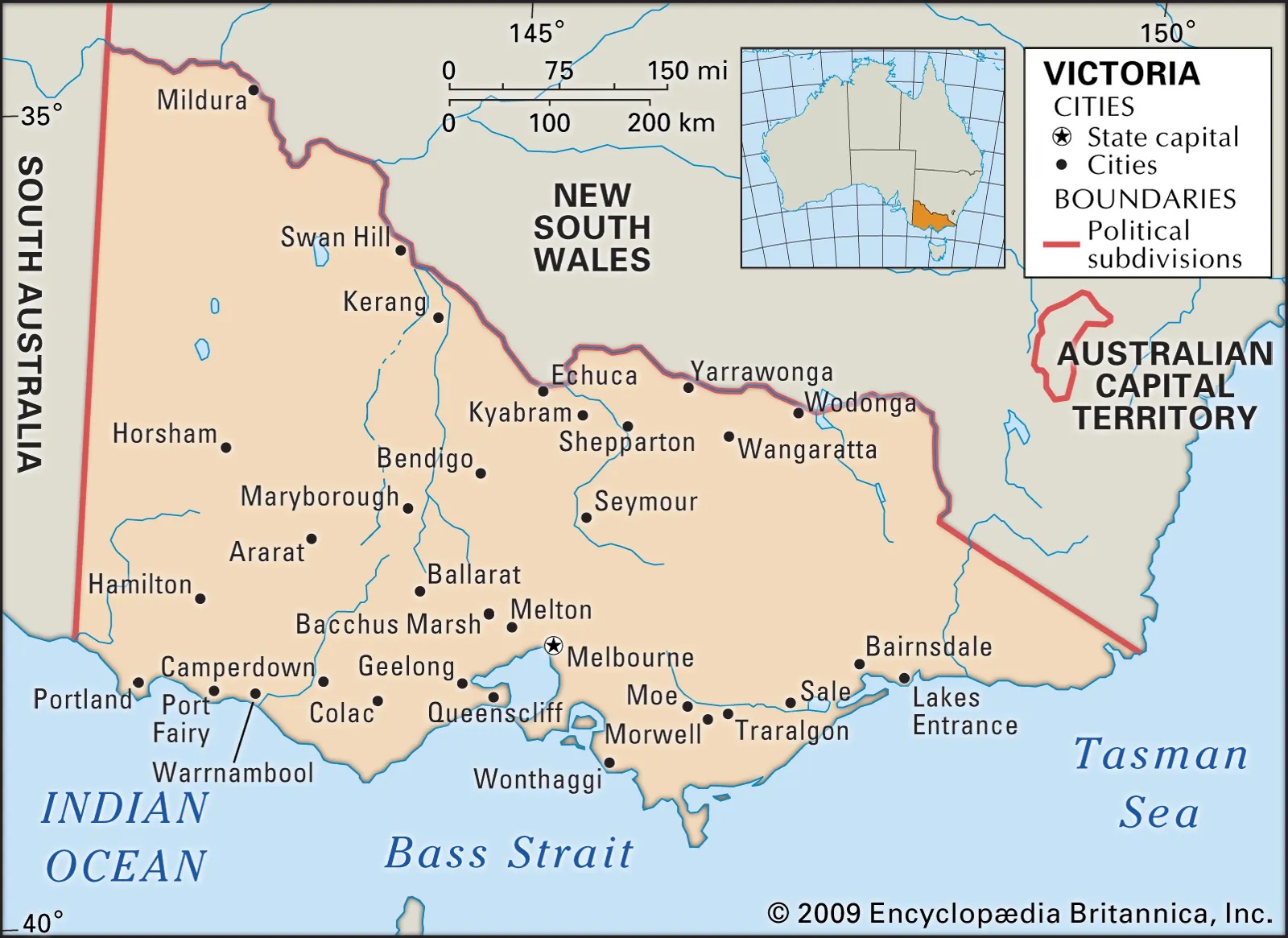
For more on the map of Victoria https://www.britannica.com/place/Victoria-state-Australia
Coat of Arms for Victoria
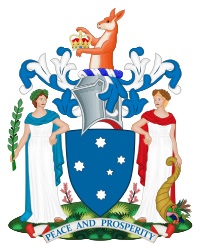 The coat of arms of Victoria is the official heraldic symbol of the Australian state of Victoria. Victoria was the second state of Australia to gain arms, granted on 6 June 1910 by royal warrant of King George V. The state had been named in 1851 after his grandmother, who was in reign at the time. The final version of the arms was granted on 28 March 1978 in the royal warrant issued by Queen Elizabeth II.
The coat of arms of Victoria is the official heraldic symbol of the Australian state of Victoria. Victoria was the second state of Australia to gain arms, granted on 6 June 1910 by royal warrant of King George V. The state had been named in 1851 after his grandmother, who was in reign at the time. The final version of the arms was granted on 28 March 1978 in the royal warrant issued by Queen Elizabeth II.
For more on Victoria’s Coat of Arms https://en.wikipedia.org/wiki/Coat_of_arms_of_Victoria_%28Australia%29
Flag for Victoria
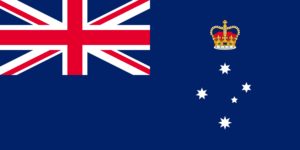 The flag of Victoria, symbolising the state of Victoria in Australia, is a British Blue Ensign defaced by the state badge of Victoria in the fly. The badge is the Southern Cross surmounted by an imperial crown, which is currently the St Edward’s Crown. The stars of the Southern Cross are white and range from five to eight points with each star having one point pointing to the top of the flag. The flag dates from 1870, with minor variations, the last of which was in 1953. It is the only Australian state flag not to feature the state badge on a round disc.
The flag of Victoria, symbolising the state of Victoria in Australia, is a British Blue Ensign defaced by the state badge of Victoria in the fly. The badge is the Southern Cross surmounted by an imperial crown, which is currently the St Edward’s Crown. The stars of the Southern Cross are white and range from five to eight points with each star having one point pointing to the top of the flag. The flag dates from 1870, with minor variations, the last of which was in 1953. It is the only Australian state flag not to feature the state badge on a round disc.
For more on Victoria’s Flag https://en.wikipedia.org/wiki/Flag_of_Victoria_(Australia)
Emblems of Victoria
Animal Emblem
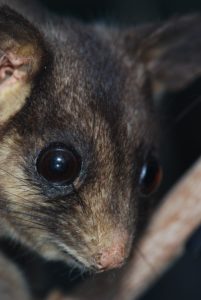 Leadbeater’s possum is a critically endangered possum largely restricted to small pockets of alpine ash, mountain ash, and snow gum forests in the Central Highlands of Victoria, Australia, north-east of Melbourne. It is primitive, relict, and non-gliding, and, as the only species in the petaurid genus Gymnobelideus, represents an ancestral form. Formerly, Leadbeater’s possums were moderately common within the very small areas they inhabited; their requirement for year-round food supplies and tree holes to take refuge in during the day restricts them to mixed-age wet sclerophyll forest with a dense mid-story of Acacia. The species was named in 1867 after John Leadbeater, the then taxidermist at the Museum Victoria. They also go by the common name of fairy possum. On 2 March 1971, the State of Victoria made the Leadbeater’s possum its faunal emblem.
Leadbeater’s possum is a critically endangered possum largely restricted to small pockets of alpine ash, mountain ash, and snow gum forests in the Central Highlands of Victoria, Australia, north-east of Melbourne. It is primitive, relict, and non-gliding, and, as the only species in the petaurid genus Gymnobelideus, represents an ancestral form. Formerly, Leadbeater’s possums were moderately common within the very small areas they inhabited; their requirement for year-round food supplies and tree holes to take refuge in during the day restricts them to mixed-age wet sclerophyll forest with a dense mid-story of Acacia. The species was named in 1867 after John Leadbeater, the then taxidermist at the Museum Victoria. They also go by the common name of fairy possum. On 2 March 1971, the State of Victoria made the Leadbeater’s possum its faunal emblem.
Bird Emblem
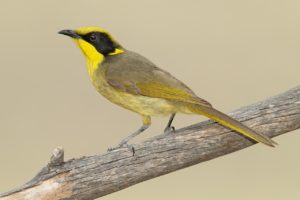 The helmeted honeyeater is a passerine bird in the honeyeater family. It is a distinctive and critically endangered subspecies of the yellow-tufted honeyeater, that exists in the wild only as a tiny relict population in the Australian state of Victoria, in the Yellingbo Nature Conservation Reserve. It is Victoria’s only endemic bird and was adopted as one of the state’s official symbols.
The helmeted honeyeater is a passerine bird in the honeyeater family. It is a distinctive and critically endangered subspecies of the yellow-tufted honeyeater, that exists in the wild only as a tiny relict population in the Australian state of Victoria, in the Yellingbo Nature Conservation Reserve. It is Victoria’s only endemic bird and was adopted as one of the state’s official symbols.
Floral Emblem
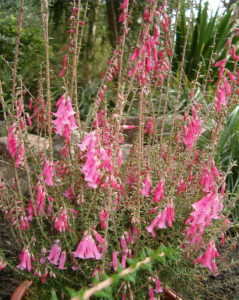 Epacris impressa, also known as common heath, is a plant of the heath family, Ericaceae, that is native to southeast Australia (the states of Victoria, Tasmania, South Australia and New South Wales). Four forms have been identified, but no subspecies are recognised. Growing in heathland, shrubland or open forest, it is generally a small shrub around 0.5 to 1 m (1 ft 8 into 3 ft 3 in) tall, with small stiff leaves. The red, pink or white tube-like flowers appear from late autumn to early spring.
Epacris impressa, also known as common heath, is a plant of the heath family, Ericaceae, that is native to southeast Australia (the states of Victoria, Tasmania, South Australia and New South Wales). Four forms have been identified, but no subspecies are recognised. Growing in heathland, shrubland or open forest, it is generally a small shrub around 0.5 to 1 m (1 ft 8 into 3 ft 3 in) tall, with small stiff leaves. The red, pink or white tube-like flowers appear from late autumn to early spring.
Marine Emblem
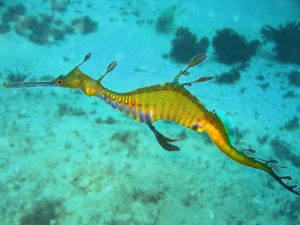 The common seadragon or weedy seadragon is a marine fish related to the seahorses. Adult common seadragons are a reddish colour, with yellow and purple markings; they have small leaf-like appendages that resemble kelp fronds providing camouflage and a number of short spines for protection. Males have narrower bodies and are darker than females. Seadragons have a long dorsal fin along the back and small pectoral fins on either side of the neck, which provide balance. Common seadragons can reach 45 cm (18 in) in length.
The common seadragon or weedy seadragon is a marine fish related to the seahorses. Adult common seadragons are a reddish colour, with yellow and purple markings; they have small leaf-like appendages that resemble kelp fronds providing camouflage and a number of short spines for protection. Males have narrower bodies and are darker than females. Seadragons have a long dorsal fin along the back and small pectoral fins on either side of the neck, which provide balance. Common seadragons can reach 45 cm (18 in) in length.
Mineral Emblem
Gold is a chemical element with the symbol Au (from Latin: aurum) and atomic number 79, making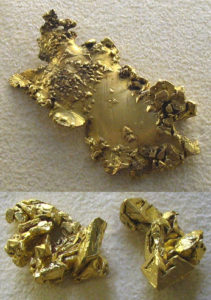 it one of the higher atomic number elements that occur naturally. It is a bright, slightly orange-yellow, dense, soft, malleable, and ductile metal in a pure form.
it one of the higher atomic number elements that occur naturally. It is a bright, slightly orange-yellow, dense, soft, malleable, and ductile metal in a pure form.
For more on Victoria’s Emblems https://en.wikipedia.org/wiki/Symbols_of_Victoria_(Australia)
Colour Emblem
Navy blue, White and Silver
For more on the Colour Emblems https://en.wikipedia.org/wiki/Australian_state_and_territory_colours